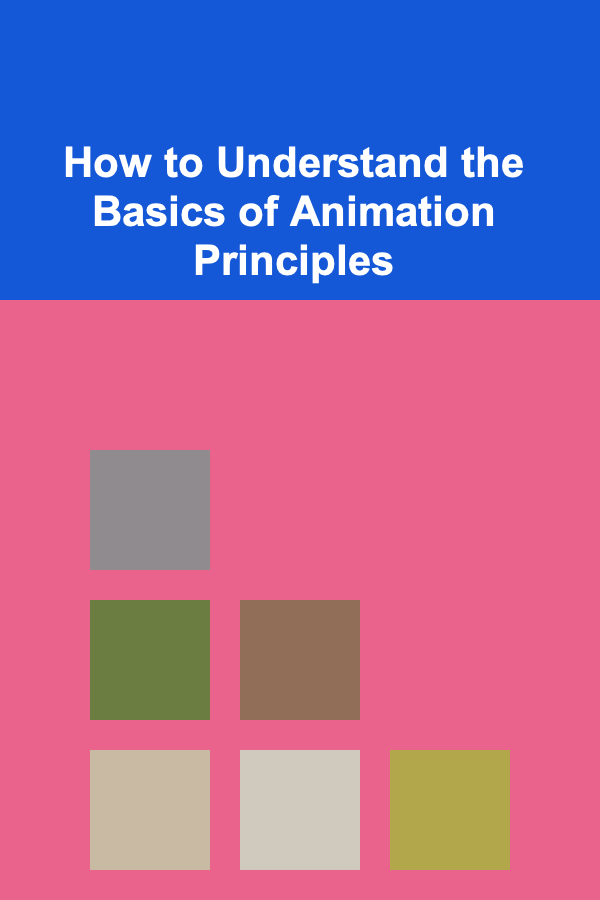
How to Understand the Basics of Animation Principles
ebook include PDF & Audio bundle (Micro Guide)
$12.99$10.99
Limited Time Offer! Order within the next:

Animation is an art form and a technique that involves bringing images to life by creating the illusion of motion. At its core, animation is all about storytelling, expression, and creating a world where characters, objects, and environments feel alive and dynamic. However, achieving realistic and engaging animation requires more than just drawing frames. It necessitates understanding and applying a set of fundamental principles that guide the creation of motion. These principles have been honed over decades of animation practice and were originally developed by animators at Walt Disney Studios in the 1930s. These 12 principles of animation, though simple, form the foundation of nearly all animation, from the traditional to the modern digital forms.
In this article, we will explore the basics of these principles, their importance, and how they help animators bring their creations to life. Whether you're just starting in animation or looking to refine your craft, understanding these core principles will enhance your ability to create compelling, lifelike animations that resonate with audiences.
Squash and Stretch
The principle of squash and stretch is one of the most important concepts in animation. It refers to how an object or character deforms (squashes) when it is compressed, and then stretches back into its original form when the force is released. This principle helps convey weight, volume, and flexibility, making objects and characters appear more dynamic and alive.
In real life, when a ball bounces, for example, it flattens upon hitting the ground and then stretches as it pushes off. This deformation is key to giving objects a sense of weight and materiality. Squash and stretch are particularly important in character animation, where it helps emphasize a character's emotions or the force of actions.
How to use squash and stretch effectively:
- Squash: Apply a squashing effect to objects when they are in a high-pressure situation, like when something is falling or hitting the ground.
- Stretch: Use stretching for fast movements, like a character running or a person reaching out quickly.
By using squash and stretch, animators can make objects and characters feel like they have physical properties, reacting to forces and their environment in a natural way.
Anticipation
Anticipation is the act of preparing an audience for a major action that will occur. In real life, before you make a big movement---such as throwing a ball or jumping---your body makes small, preparatory movements. For example, before you jump, you bend your knees first. These subtle actions signal to the audience what's going to happen next and give them the opportunity to understand the motion, making the eventual action feel more realistic.
How to use anticipation effectively:
- Before any major action, give a small movement that hints at what will follow. For instance, a character winding up before throwing a punch, or bending down before leaping into the air.
- Anticipation doesn't have to be exaggerated, but it should be noticeable enough to create an expectation of what's to come.
Proper use of anticipation ensures that actions feel more believable and dynamic, and it also helps the audience understand the physical laws behind those actions.
Staging
Staging is about presenting an action in such a way that it is clear and easy for the audience to understand. This principle involves directing attention to the important parts of the animation by using elements like framing, lighting, and composition. Staging is crucial to ensuring that the message or emotion being conveyed is not lost in the clutter of unnecessary details.
How to use staging effectively:
- Use clear focal points: Make sure the action or emotion you want to convey is the focal point of the frame.
- Consider the background: Avoid clutter in the background that distracts from the main subject of the animation.
- Use composition to guide the viewer's eye: Position characters or objects in ways that naturally lead the viewer's gaze to important moments.
Staging ensures that the audience is always focused on the most important elements of the story or action, enhancing the clarity and impact of the animation.
Straight Ahead Action and Pose to Pose
There are two main approaches to animation: straight ahead action and pose to pose. Both are valid techniques, and understanding the difference between them is essential for creating dynamic and fluid animations.
- Straight ahead action involves drawing each frame in sequence, from start to finish. This technique often results in very fluid and organic motion, but it can be difficult to control, especially for complex actions.
- Pose to pose, on the other hand, involves creating key poses first and then filling in the in-between frames. This technique is useful for maintaining control over the timing and structure of the animation while still achieving smooth transitions.
How to use straight ahead action and pose to pose effectively:
- Use straight ahead action for more chaotic or organic movements, like explosions or fast actions where fluidity is key.
- Use pose to pose for scenes that require clear timing, dramatic poses, or action sequences that need a more structured approach.
Choosing the right approach for a given scene can significantly impact the look and feel of the animation.
Follow Through and Overlapping Action
Follow through refers to the continuation of an object's motion after the main action has stopped. For example, a character's hair or clothing may keep moving after they stop running. Overlapping action occurs when different parts of a character or object move at different rates. For instance, a character's arms might move more slowly than their body, or their head might follow the movement of the body with a slight delay.
These principles give the impression that different parts of the body or objects are moving independently, making the animation feel more natural and believable. In real life, not everything moves at once; some parts lag behind, and others keep moving after the main action stops.
How to use follow through and overlapping action effectively:
- Use follow through to enhance the realism of fast movements, like when a character's hair or cape flutters after they've stopped.
- Use overlapping action to create more complexity and depth in movements. For example, have a character's head follow their body with a slight delay when they change direction.
By incorporating these principles, the movement of objects and characters will feel less mechanical and more in tune with how things move in the real world.
Slow In and Slow Out
Slow in and slow out refers to the acceleration and deceleration of motion. Most movements start off slowly, speed up in the middle, and then slow down again before coming to a stop. This is true of both real-world motion and animated motion. Adding slow ins and slow outs to your animation makes the movement feel more natural and smooth, as it mimics how things accelerate and decelerate in reality.
How to use slow in and slow out effectively:
- When animating, focus on easing the start and end of movements to create a more realistic flow.
- Add more in-between frames where there are slow in and slow out moments to emphasize the gradual acceleration and deceleration.
Incorporating this principle can make your animations feel more polished and natural by introducing fluidity and rhythm to the movement.
Arcs
In the real world, most natural movements follow an arc or a curved path. Think of the motion of an arm when someone swings it or the way a ball bounces. Using arcs in animation is key to making the movement feel grounded and realistic.
How to use arcs effectively:
- Plan movements with a clear arc, especially for things like jumping, throwing, or swinging.
- Avoid rigid, straight-line movements unless they are intentionally mechanical or exaggerated for effect.
Arcs create fluid, organic motion and prevent your animations from feeling stiff or unnatural.
Secondary Action
Secondary action refers to smaller, supporting movements that accompany the primary action. These actions can add depth and realism to the animation by making the scene feel more full and lifelike. For example, when a character runs, their arms and legs move, but the character's hair or clothing may move in a secondary, less important way to enhance the overall motion.
How to use secondary action effectively:
- Add secondary movements that don't distract from the primary action but instead complement and enhance it.
- Think about how the surroundings or smaller details can react to the main action.
Secondary actions help to enrich the animation and add complexity, making the world feel more immersive.
Timing
Timing is crucial in animation. It dictates how fast or slow an action occurs and how long it takes for objects to complete their movements. The right timing creates rhythm and helps the viewer perceive the action as believable. Different actions require different timing to convey the appropriate weight, speed, or emotion.
How to use timing effectively:
- Vary the timing based on the action's intensity or significance.
- Use slower timing for heavy or dramatic movements and faster timing for quick, light actions.
Proper timing can make all the difference in how the audience perceives an animation and how engaging it feels.
Exaggeration
Exaggeration is about pushing actions, movements, and expressions beyond what is realistic to make them more dynamic and entertaining. Exaggeration helps to communicate emotion and action more clearly, adding life and excitement to the animation.
How to use exaggeration effectively:
- Exaggerate physical movements to make them more expressive, such as stretching a character's face when they are shocked or expanding their body when they're stretching.
- Avoid over-exaggerating to the point where it distracts from the core action, but feel free to amplify the emotion or action for impact.
Exaggeration, when used correctly, helps amplify the emotions and story of the animation, making it more compelling and entertaining.
Solid Drawing
Solid drawing refers to the technique of creating well-constructed, three-dimensional figures that have a sense of weight and volume. The goal is to make characters and objects look as though they are part of a three-dimensional world, even though they are being represented on a flat surface. Solid drawing involves understanding anatomy, perspective, and the way light affects form.
How to use solid drawing effectively:
- Study basic anatomy and perspective to ensure your characters and objects feel like they exist in a three-dimensional space.
- Pay attention to light and shadow to give your figures depth and weight.
Solid drawing is essential for creating convincing, lifelike characters and objects in animation.
Appeal
The final principle, appeal, refers to the charisma or attractiveness of a character or design. A character with appeal is engaging, and they draw the audience in with their personality and design. Appeal doesn't necessarily mean making a character cute or pretty, but it's about creating something that resonates with the viewer and has a certain charm or energy.
How to use appeal effectively:
- Focus on creating characters that are visually interesting and engaging, with well-defined personalities.
- Use design, facial expressions, and body language to give characters appeal and make them memorable.
Appeal is the secret ingredient that makes characters stand out and connect emotionally with the audience.
Conclusion
Animation is a complex, multifaceted art form, and the principles outlined here are the foundation upon which all good animation is built. Whether you're an animator or an enthusiast looking to understand the intricacies of this creative process, mastering these principles will significantly improve your ability to create animations that are both realistic and engaging. These principles help you to focus on the fundamental aspects of motion, timing, and character development that make an animation feel alive and captivating. By practicing these principles, you'll be able to bring your animations to life with greater depth, fluidity, and emotional impact.

How to Make Money Online as a Graphic Artist: 10 Actionable Ideas
Read More
How to Understand AI-Powered Drug Discovery
Read More
How To Master Regular Expressions for Data Validation
Read More
How to Acquire Basic Home Brewing Skills
Read More
How to Build a Board Game Playing Community
Read More
10 Tips for Choosing the Right Playing Cards for Throwing
Read MoreOther Products

How to Make Money Online as a Graphic Artist: 10 Actionable Ideas
Read More
How to Understand AI-Powered Drug Discovery
Read More
How To Master Regular Expressions for Data Validation
Read More
How to Acquire Basic Home Brewing Skills
Read More
How to Build a Board Game Playing Community
Read More